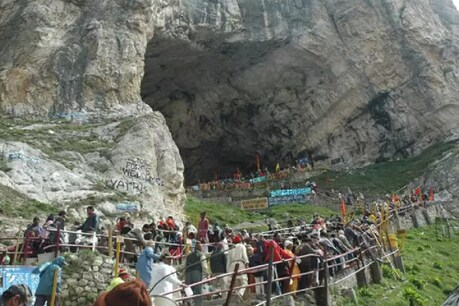Amarnath Yatra, one of India’s most visited yet toughest pilgrimage, holds a significant value for Hindu Devtoees. Piligrims await the whole year for this journey as the holy cave is accessible only for a few weeks in summer. Situated at a height of approximately 13,000 ft above sea level in Kashmir Valley, Amarnath Yatra draws hundreds of pilgrims every year, especially because of its ice-encased Shivalinga. This year the yatra will begin from June 29 and will conclude on August 19, registrations of which have already begun.
Amarnath Yatra: Routes
Amarnath Yatra has two routes, both operated and managed by Shri Amarnath Ji Shrine Board (SASB). One is via Pehlgam, which is longer but easier compared to the second one via Baltal- which is shorter, but not recommended for everyone. However, both the routes will take you on a divine journey with breathtaking views of snow-capped mountain peaks.You can opt for air, train, or bus route as per your convenience. For air travel, the closest airport is Srinagar Airport, located 72 Kms from Amarnath Cave Temple, while the closest railway station is Jammu Tawi which is situated at a distance of 176 Kms. Private operators or State Transport buses also offer bus services from Jammu to Pahalgam and Baltal.
Route 1: Baltal To Amarnath Route
This 14-kilometre route in the Ganderbal district, can be covered within 1 or 2 days, although it is not for beginners as it involves steep ascents and descents, tough-to-climb terrains, and shortcuts that can drain your energy soon. This route is best for people who are young, fit, and seeking some adventure amidst the religious trip. The base camp for this route is located at Baltal (near Sonamarg) which is around 95 Kms from Srinagar via road and the Yatra Access Control Gate is located at Domail.
- Route Map: Baltal – Domali – Barari – Sangam – Amarnath Cave
After beginning your trek from Baltal, you can take your first halt at Domali, which is approximately after 2 kilometres of trekking. Continue onward to Barari, a further 6 kilometres ahead. You can take a short break here, following another 4 Kms trek to Sangam, which will be your next held point.
Sangam marks a significant milestone as you have covered roughly 80% of your journey by then, with the Amarnath Cave just 2 kilometers beyond its bounds.
Route 2: Pahalgam To Amarnath Route
This second route of 45 kilometres start from Pahalgam and requires almost 4 to 5 days of walking. People usually opt for this longer trek for it’s mesmerizing views, better enroute facilities and easy to climb terrains, compared to Baltal route.
Lidder and Aru Rivers flowing between the high mountains will leave you fascinated during the trek. Here, the Yatra base camp is located at Nunwan, 6 kilometres from Pahalgam, where devotees take halt at night.
- Route Map: Pahalgam – Chandanwadi – Pissu Top – Zoji Bal – Naga Koti – Sheshnag – Warbal – Mahagunas Top – Pabibal – Panchtarni – Sangam – Cave
Although you will find camps for staying all along the way, it is suggested to reach Chandanwari before the second night. The distance from Pahalgam to Chandanwari is 16 km, where you can find mini-buses running in between.
Read More: Massive Fire Breaks Opposite Patna Junction As Hotel Near Golambar Catches Fire; 6 People Trapped
From Chandanwari, you have to climb a height to reach the next stop, Pissu Top.
Further, a 13 km trek to Sheshnag will lead you to the Sheshnag Lake where devotees take a bath. Continuing on the same route, a 4.6 kilometer trek to Panchtarni is a steep ascent and descent across Mahagunas Pass at 14000 ft. People can suffer from oxygen deficiency and nausea at this height.
According to the Board, at Panjtarni, at the feet of Mount Bhairav, five rivers flow which apparently originated from Lord Shiva’s hair.
After this, you will be left with almost a 2-3 km trek to the holy shrine which will take you through the sangam of Amravati and Panjtarni rivers. Some pilgrims take a bath at Amravati also before leaving for the darshan. There are two smaller Shivlings as well, one of Maa Parvati and the other of Shri Ganesh.
It may be noted that after having early darshan of the Shiv Lingam, one can return to Panjtarni well in time on the same day itself. Devotees can hire ponies/ labourers and use trekking poles for support. They can also opt for a helicopter service if they are not fit to walk on any of the routes.
You can check the tariff structure and book helicopter and ponies in advance from here.
Both routes have their own kind of challenges and demand lots of physical and mental fitness. Being one of India’s most visited pilgrimages, the government of Jammu & Kashmir, along with NGOs, makes all the arrangements for accommodation, food, and security on both routes.
Amarnath Now Accessible By Road:
On November 2, 2023 Border Roads Organisation (BRO) announced that now the holy cave shrine of Amarnath is accessible through a motorable road as well.
BRO posted a video On X (formally Twitter) showing its vehicle moving through the newly constructed Baltal-Cave shrine road.
Read More: Massive Landslide Hits Arunachal Pradesh, Highway Along China Border Washed Away
The BRO officials stated that the task has been completed, and vehicles can now travel all the way to Amarnath Cave from Dumail, via the Baltal base camp, which is 86 kilometres north of Srinagar. Newly constructed roads under the BRO’s project ‘Beacon’ aim to make the pilgrimage more convenient for devotees, especially considering the responsibility for maintaining the tracks leading to the cave shrine.
This will be the first time when a motorable road will be available to reach the Amarnath Cave. However, there has been no notification made by the Shri Amarnath Ji Shrine Board or the BRO about how devotees can access the road.
On one hand, this remarkable achievement of BRO will make the pilgrimage convenient, while on the other, the same achievement is attracting criticism from politicians to environmentalists who fear adverse impacts of the road on the cave shrine and the fragile ecology of the area.



































